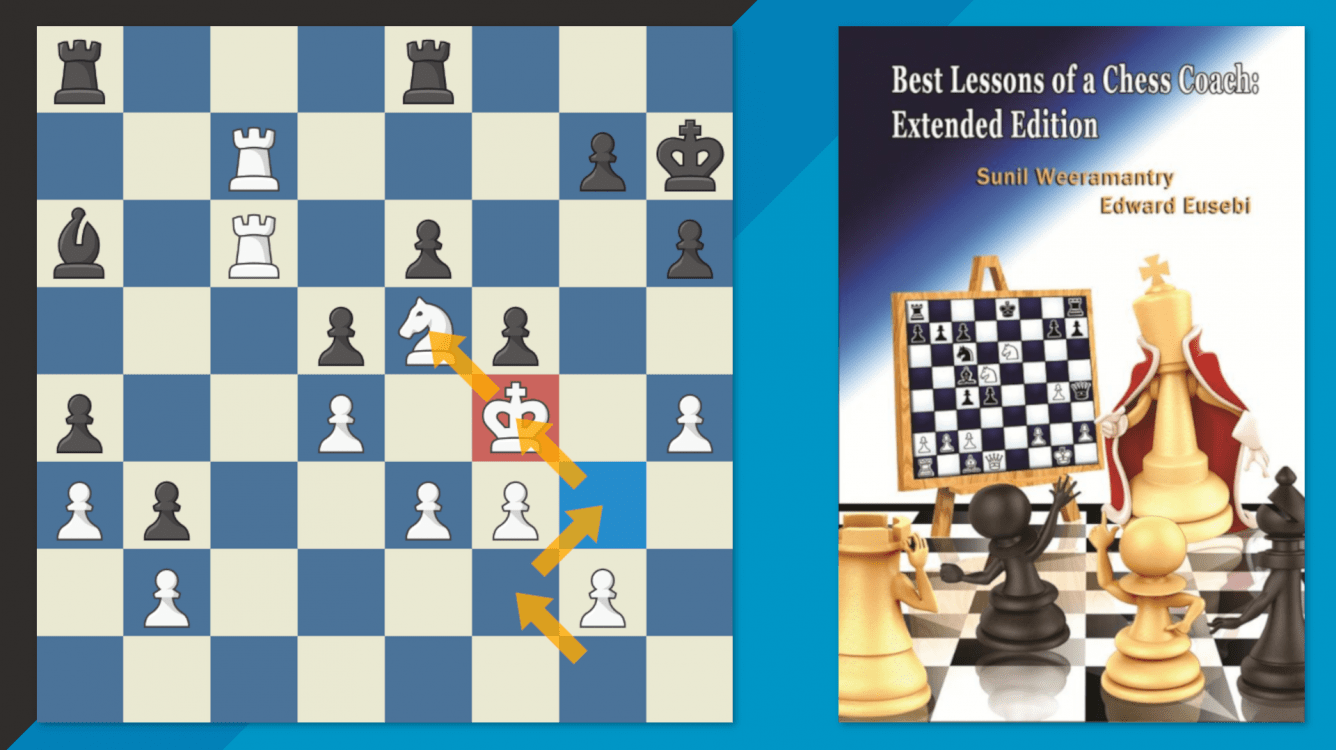
Review: 'Best Lessons Of A Chess Coach' By Sunil Weeramantry
Chess is a “theoretical” game, and books on chess theory are plentiful. It is also a very “practical” game because chess theory has to be worked out in practice—on the chess board!
This splendid book builds on the success and wide acclaim of the 1993 edition by adding new features. The popularity of the earlier book recognized that this was chess instruction at its very best. It was written by top players and chess educators who combined a number of features that made the book eminently accessible, practical, and helpful in aiding players to strengthen their chess-playing abilities and gain deeper perceptions of issues, tactics, and strategy as they plan and assess board situations. This new edition of "Best Lessons of a Chess Coach" clarifies, refines, and expands upon the original work to teach and inspire a whole new generation of chess players. Make no mistake, the 2020 edition is not just a rehash with a new cover!
FIDE Master Sunil Weeramantry is a two-time New York State Champion and an acclaimed educator who is the Founder and Executive Director of the National Scholastic Chess Foundation (NSCF). He is one of the most successful chess coaches in the United States. He is also stepfather and first coach of the 5X U.S. champion GM Hikaru Nakamura. Ed Eusebi is a Candidate Master in both over-the-board and correspondence chess. Together, they have given us an excellent, engaging resource which provides a you-are-there experience as one works through outstanding games drawn from the history of chess. As one person commented on the earlier book, the instruction is what you would imagine if the best teacher you ever had in school was sitting next to you, teaching you chess!
Alekhine vs. Yates, the first illustrative game in the book.
The extended edition has four parts: Outpost Squares, Weak Squares, The Initiative, and Coordination and Control. Each part features several "Lessons" and "Illustrative Games." Each lesson presents a complete game that demonstrates one or more themes. These lessons are presented as dialogues where questions are posed and answers given. This “Socratic dialogue” approach enables readers to stop and ponder what is being asked and what is at stake in the game as various options for moves are considered. Suggested answers present alternatives—which are discussed as right or wrong when then a right path ahead is indicated. The game is followed through book diagrams, and, since this book is, gratefully, also available on the Forward Chess app, the games can be played directly through the app.
Within the lessons, exercises are given to enable variations to be explored. In a question/answer style, these are effective means of enlarging one’s vision of board situations and thinking of what is at stake with each move. In Sunil’s games and commentary, we become aware of his thought processes and wise reflections. For example, on the twelfth move of a King’s Indian Defense opening he reflected:
"This is a challenging move. If Kasparov had played 12.c5, I would probably be sitting there shaking! I would think this is some incredible move, just because of the person who played it. Well, you have to forget about who you are playing against and focus on the position at hand. When confronted with a novel or surprising move, take your time. Do not rush your reply. It is always scary to leave the security of the familiar behind you, but a chess player must have the confidence and the courage to strike out on his own. Personally, I find the prospect of creating something new to be quite exciting!" (p. 32)
I find the prospect of creating something new to be quite exciting! - Sunil Weeramantry
Comments like these really help to bring games to life!

Each lesson provides a review made up of “Themes,” with references to game moves listed and “Advice” which gathers up insights from the lesson. In one lesson, we find these themes: "Opening the position to exploit an advantage in mobility"; "Supporting the center"; and "Attacking on the weak side." Advice: "A loss in time must be exploited immediately;" "When analyzing long variations, understanding where to pause your analysis is important. Save time on your clock and think on your opponent’s time;" and "Attack where the enemy is weak." These compact nuggets of wisdom can stay with you and provide insights for your games ahead.
An invaluable conclusion to each of the four parts of the book is a series of illustrative games. These are drawn from across chess history, including a Paul Morphy game from 1857 and a game from 2019. Major chess players are well-represented, including Emanuel Lasker, Capablanca, Alekhine, Nimzowitsch, and Fischer. These games highlight themes of the lessons and feature masterful annotations and exercises to follow. An extensive—and very useful—glossary defines a range of terms and concludes the book.
Interesting tidbits about games also appear. In W. Steinitz vs. C. von Bardeleben’s 1895 Hastings Tournament game, the authors recount: “A famous story is told about this game. Steinitz was out of the room when von Bardeleben realized he was lost. He left a note saying, ‘Saw it—went home.’ What made von Bardeleben give up without formally resigning was something truly amazing, as you will see. The final combination is so stunning that Steinitz is said to have been very upset when he realized he would not get a chance to play it. His only satisfaction was to show it to the spectators after the game.” (p. 167)
Sure enough, the game illustrates Steinitz’s closing combination where we see at one point that “typically, a mating attack involving a queen would include sweeping moves that emphasize the long-range power of the piece. In this game, however, the queen has moved just one square at a time for six consecutive moves, squeezing Black’s king to a slow and painful death.” (p. 186) In the end, “the final mating combination is a classic illustration of the harmonious collaboration between queen and knight.” (p. 187) This ending is a thing of beauty!
Steinitz vs. von Bardeleben. The first rage-quit.
Also notable is the D[onald] Byrne vs. Bobby Fischer game from New York, 1956. Fischer, playing Black, was only thirteen-years old at this time. On move 17, Fischer sacrificed his queen. “The power of this move by the 13-year-old Fischer has resulted in this game being dubbed ‘The Game of the Century,’” say our authors since “Black gives up his queen for a spectacular finish.” (p. 352) By Fischer’s 32nd move, he had protected all his pieces and pawns so, “there is simply nothing for White to attack.” (p. 353) By move 37, “Fischer now finishes with a mate in five moves. When it was pointed out to him that he had a faster mate, he replied that he simply played the win he found.” (p. 354)
Fischer's "Game of the Century."
This is a gem of a book! It is clearly organized, written in an inviting style with accessible, interactive features. Two chessmasters have shared their knowledge and wisdom to help all readers improve their playing. We can easily believe what the editor, Robert McLellan, wrote in the Introduction to this edition: “In the time I have been working with Sunil, I cannot count how often people have commented that 'Best Lessons of a Chess Coach' is among their top two or three books because of how much they learned.” (p. ix) This book can become that for you too!
Sunil Weeramantry and Edward Eusebi. Best Lessons of a Chess Coach: Extended Edition. Boston: Mongoose Press, 2020. 411 pgs. Paper. Available from https://nscfchess.org/best-lessons-of-a-chess-coach/.
Donald K. McKim
Germantown, Tennessee



